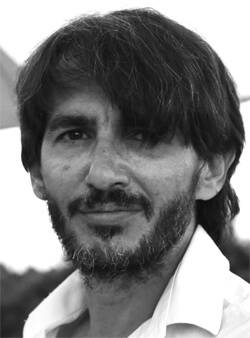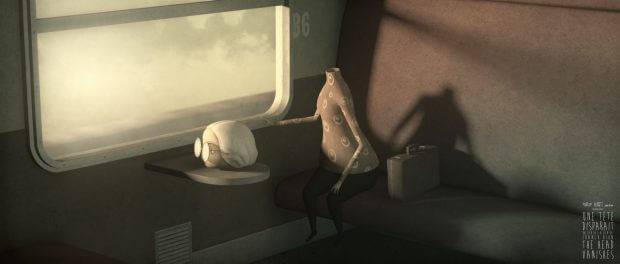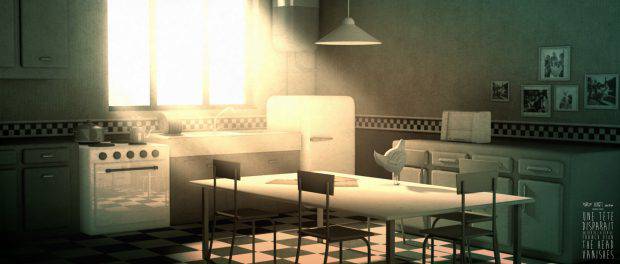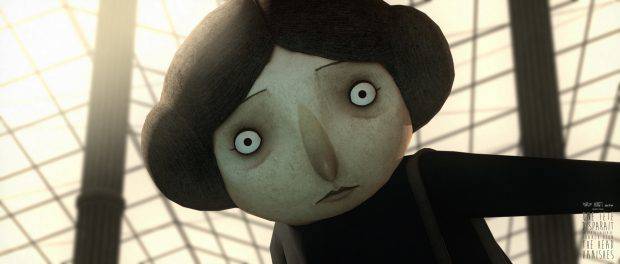Interview with Franck Dion (‘The Head Vanishes’)
UPDATE: Franck Dion’s The Head Vanishes recently won the Short Film Cristal at this year’s Annecy International Festival of Animated Film!
 Following a firmly-established and much-celebrated filmography that includes the multi-award winning shorts The Phantom Inventory (2006), Monsieur Cok (2008) and the Annecy Special Jury Prize-winning Edmond Was A Donkey (2012), Versaille-born, Paris-based Franck Dion returns this month with his latest film The Head Vanishes (Une tête disparaît), set to premiere at the Annecy Festival this week with upcoming screenings at EIFF, NAFF, BISFF, HIFF and Curtas Vila do Conde lined up already. In the film (produced by Julie Roy of the NFB and Hélène Vayssières of Arte in collaboration with Franck’s own studio Papy3D) we meet Jacqueline, a woman in the autumn of her years determined to make her yearly trip to the seaside. Impeding her journey is a mysterious younger woman who insists that Jacqueline is her mother, unrelentingly following her despite being a complete stranger. What ensues is an assortment of touching and fantastical visual scenarios, depicting a sometimes-beautiful, sometimes-dangerous world as seen from the perspective of an elderly woman with degenerative dementia. With a rich visual strength that once again marries Franck’s keen illustrative eye for colour, composition and atmosphere with novel CG animation approaches, The Head Vanishes stands out as one of the gems of the Annecy Festival’s 2016 official selection. We’re delighted to welcome Franck Dion to Skwigly for the first time and learn more about this profoundly thoughtful film.
Following a firmly-established and much-celebrated filmography that includes the multi-award winning shorts The Phantom Inventory (2006), Monsieur Cok (2008) and the Annecy Special Jury Prize-winning Edmond Was A Donkey (2012), Versaille-born, Paris-based Franck Dion returns this month with his latest film The Head Vanishes (Une tête disparaît), set to premiere at the Annecy Festival this week with upcoming screenings at EIFF, NAFF, BISFF, HIFF and Curtas Vila do Conde lined up already. In the film (produced by Julie Roy of the NFB and Hélène Vayssières of Arte in collaboration with Franck’s own studio Papy3D) we meet Jacqueline, a woman in the autumn of her years determined to make her yearly trip to the seaside. Impeding her journey is a mysterious younger woman who insists that Jacqueline is her mother, unrelentingly following her despite being a complete stranger. What ensues is an assortment of touching and fantastical visual scenarios, depicting a sometimes-beautiful, sometimes-dangerous world as seen from the perspective of an elderly woman with degenerative dementia. With a rich visual strength that once again marries Franck’s keen illustrative eye for colour, composition and atmosphere with novel CG animation approaches, The Head Vanishes stands out as one of the gems of the Annecy Festival’s 2016 official selection. We’re delighted to welcome Franck Dion to Skwigly for the first time and learn more about this profoundly thoughtful film.
For the benefit of myself and our UK readers, I’d love to use the opportunity to learn more about your background. Can you tell us a little bit about the work you have done leading up to this film as well as the path that led you to animation directing (I note in your bio that you studied acting/theatre, did this have any part to play)?
My path was somewhat atypical, because I left school early and never went to art school. My passion for theatre, film and illustration led me to the arts disciplines that I trained in. I worked as an actor in theatre, as an illustrator for the press and for game publishers, I designed theatre sets, and I did animated sequences for documentaries. At the same time, I was writing scripts, with an eye to one day making a film. I met Didier Brunner (the producer of Kirikou, The Triplets de Belleville and Ernest & Celestine) in the late 1990s, and that allowed me to make my first film, The Phantom Inventory. I think my training as an actor strongly influenced my interest in the character and his personality.
As for your latest film, The Head Vanishes, what led you to the decision to tell this type of story?
As so many people unfortunately do, I had to deal with someone close to me living with a neurodegenerative disease. The desire to use that as the subject for a script came to me as a way of paying homage to that losing battle.
The visual style, while unique in terms of design, is perhaps most evocative of your preceding film Edmond Was a Donkey. Was using this approach to the CG animation (as opposed to the more asset-based Monsieur Cok) always the intention for this project?
The Head Vanishes is about the imagination of someone who is interpreting the world around her. It’s an evanescent vision of things, just like Jacqueline’s memory. I wanted to draw a more malleable environment. There’s a link to my recent illustration work, which deals with gentler, more poetic realms.
Another quality of Edmond I’m reminded of is the exploration of mental illness from the sufferer’s perspective, without pulling any punches. Can I ask what has drawn you to this potentially uncomfortable subject matter?
With Edmond, it was important that I develop the character’s personality and actions rather clinically, so that the discomfort would settle in. People who are out of the ordinary, or actually sick, are greatly misunderstood, and that’s what I wanted to emphasize, while at the same time nurturing a form of empathy for the character. Despite their faults, I hate hating my characters!
Your visualization of the main character’s perception of the world and how it is degenerating is very effective. Were the hallucinogenic elements of the film based on research/real-life accounts at all?
The way that the main character Jacqueline’s hallucinations degenerate was partly inspired by descriptions shared with me by someone who suffered from hallucinations and waking dreams that could last for a month at a time. I adapted those descriptions to my own imagination, populated by fish, a train without a locomotive, and chickens.
I’m also fond of the story-within-the-story about the chicken. Where did this originate from?
The headless chicken story came from an early-20th-century legend about an American farmer who chopped the head off a chicken, except the bird survived and became a circus sideshow attraction! For someone like me who’s obsessed by fowl (I always put one or more in my films and in a lot of my illustrations), the opportunity was too good to pass up!
Your previous films have all been very densely illustrated/populated, whereas in this film there’s a real sense of open space for the most part. It served as a very strong means of conveying the isolation of the main character; was this a deliberate choice?
I wanted the film to be uncluttered graphically, to accentuate the sense of isolation felt by the main character, who moves in this sort of limbo populated by figments of her imagination. I also wanted the visuals to be fairly gentle and cuddly, to soften the violence of the situation that the two characters are experiencing.
I’m very enamoured of your approach to colour and lighting. Do you have any major influences (artistic/cinematic) when it comes to the haunting, desaturated look of your films?
I very much admire the paintings of Hieronymus Bosch, Francis Bacon and Francisco Goya. In cinema and photography, I’m fond of the aesthetics in films by Roy Andersson, Stanley Kubrick and Orson Welles. Photographers I like include Henri Cartier-Bresson, Richard Avedon, Diane Arbus and Eugène Atget; I’m very moved by their work.
In the past we’ve spoken with fellow Papy3D talents Sarah Van den Boom and Jérémy Clapin. Can you describe how you all came to know one another’s work and what your general role is at the studio?
Papy3D was founded 10 or so years ago when Richard van den Boom, Sarah’s husband, suggested that we start up a production company in which we’d be partners. Besides Sarah and Jeremy Clapin, the company includes director Gilles Cuvelier and composer Pierre Caillet. My role in Papy3D is to be the producer of my own films, which by itself is quite a bit of work.
The film again uses the music of Pierre Caillet, with whom you’ve collaborated for several films now. Can you tell us how your working relationship began and how you work together?
Pierre and I have known each other for about 15 years now. With our working method, we often start well ahead of the production stage; before the scriptwriting is finished, even. I tell him what I want, using clips of existing music, and we talk. Then Pierre works up maquettes that serve as guide tracks for the final score.
Papy3D have been collaborating with the NFB for some years now. How did you come across one another and how has their involvement benefited the films?
During production of my previous film, Edmond Was a Donkey, Hélène Vaysierres, who’s head of short-film programming at ARTE, introduced me to Julie Roy, a producer at the NFB. We just clicked, right away. The NFB came on board as co-producer, handling all the sound for the film. That’s how I had the opportunity to work with such talented people as Pierre Yves Drapeau for the sound design, Lise Wedlock for the sound FX, and Serge Boivin for the mixing. This same team handled the sound for The Head Vanishes.
You made your film The Phantom Inventory using stop-motion to great effect. Is this a medium you would ever plan to return to?
Right now I’m working on writing a 52-minute TV special that is going to use a blend of built miniature sets and characters created using both digital and paper cut-out animation. It’s going to be a very baroque world, similar to that of The Phantom Inventory.
You created some magnificent visuals for the Annecy 2014 branding. Is illustration and design still a big part of your creative output?
I love illustration; it’s a huge part of my creative process. I occasionally do illustrations for games, like for example DIXIT 5: Daydreams two years ago. When I have the time, I like posting new drawings to my Facebook page, just for the fun of it. And I may well do a book of my illustration work someday.
What plans/projects does the future hold?
I’m working on the writing and development of an interactive app for tablets in collaboration with the NFB and Akufen, a Canadian studio. I’m also working on the script for a TV special.
The Head Vanishes screens as part of Annecy 2016‘s Short Films in Competition 3, playing at:
- 13/06/2016 – 18:30, MJC Novel
- 14/06/2016 – 16:30, La Turbine
- 14/06/2016 – 20:30, Cinéma Pathé Pathé 1
- 15/06/2016 – 10:00, Cinéma Pathé Pathé 1
- 15/06/2016 – 14:00, Bonlieu Grande salle
- 15/06/2016 – 18:00, Bonlieu Grande salle
- 17/06/2016 – 16:00, Cinéma Pathé Pathé 1
- 18/06/2016 – 18:00, Cinéma Pathé Pathé 1
The film will also screening the following Tuesday (21st) at EIFF, 4:15pm Filmhouse 1
For more of Franck Dion’s work visit franckdion.net




